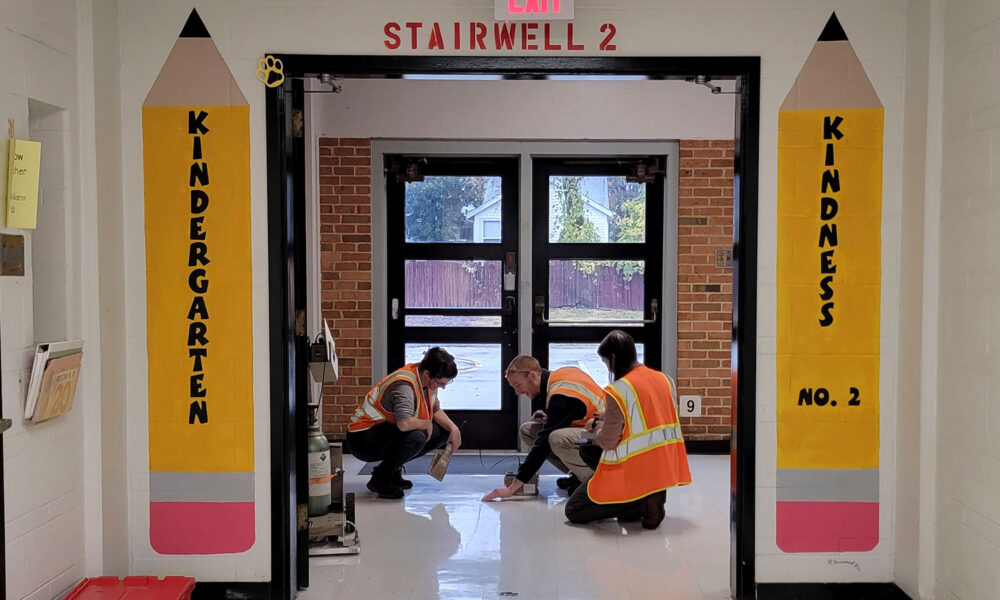EDITORIAL UPDATE, 12/16/22: this blog was updated from a previously published version. This version contains content updates and includes new information from Coldwater Creek area community members.
The families, students, and school officials in Florissant, Missouri have been living a modern nightmare for the past several weeks, learning and unlearning that Jana Elementary school and the surrounding region may have significantly higher than estimated exposure levels of radioactive contamination. This contamination derives from the production of nuclear weapons decades ago.
Radiation exposure can damage the DNA in cells leading to a host of health problems including cancer and auto-immune disorders. What’s more troubling is the Centers for Disease Control reports children and young adults, especially girls and women, are more sensitive to the effects of radiation.
Jana Elementary school has 400 students and a predominantly (82.9%) Black student body. Unfortunately, the United States has a long history of environmental racism which results in harming Black, Indigenous and Brown communities much more in the process of creating and maintaining nuclear weapons.
The suburban school north of St. Louis, Missouri, was thought to be safe for students based on research completed in 2000 by the Army Corps of Engineers (USACE).
A tale of conflicting reports
Specifically, USACE has been in the Coldwater Creek region for the last 20 years attempting to remediate radioactive waste associated with the creek (which does not include Jana Elementary).
Toward the start of the 2022 Fall semester, as part of an ongoing lawsuit in the region, the Boston Chemical Data Corp (BCDC), an environmental consulting group, reported the elementary school as having radioactive waste levels far above the national estimated exposure levels. These estimated exposure levels are based on natural (sometimes referred to as background) radioactive exposure.
By the Thanksgiving holiday break, the USACE returned to test inside and on the playground of the school and found no radiation above the expected background level on the campus, news which many community members and organizers unsurprisingly expressed as suspicious.
The School Board then hired SCI Engineering, a private engineering firm, to sample Jana Elementary who came to a similar conclusion as USACE: there were no elevated levels of radioactive waste in or immediately around the school.
When science cannot agree, the community suffers
The community has sought answers about the safety of their school for years and the conflicting information has not been reassuring.
Following the BCDC report, all Jana Elementary students were sent home for the rest of the semester in hopes their homes were less toxic.
When describing how the conflicting reports left him feeling, Hazelwood School Board treasurer told STL Today,
“I feel like we’re pawns in this.” He goes on to describe having “one report that’s biased saying that you need to get the kids out” and “another report that’s also biased that’s saying you got nothing.”
Sylvester Taylor, Hazelwood School Board Treasurer
Returning to classes from Thanksgiving break after the SCI Engineering and USACE results were shared, many wary students joined classes at new schools in the area per the school board’s decision related to BCDC’s radiation exposure assessment. Parents also expressed to National Public Radio they felt left out of discussions for decisions being made.
This back and forth reporting left the Jana Elementary community confused, concerned, and many parents upset.
The radioactive waste was released decades ago
Nuclear weapons were built using uranium through World War II, and later, the waste from this production was stored in many areas across the US including the Coldwater Creek area.
Coldwater Creek runs for 19 miles throughout the area and flows directly into the Missouri River. The creek and its floodplain soil (which has been used in construction further from the creek) has been noted as having radioactive contamination and regularly floods into nearby neighborhoods.
Jana Elementary is bordered by the creek on two sides but has to date not been included in any clean-up efforts by the US Army Corps of Engineers (USACE).

Different sampling methods were used in the reports
Prior to the Boston Chem Data Corp 2022 report, the USACE did not take any samples within 300 feet of the school building in their 2017 assessment.
Marco Kaltofen, an environmental engineer who is leading the BCDC team, suggests that BCDC’s method better picks up the microscopic radioactive materials. However, Kaltofen also asserts that the BCDC study is consistent with the USACE study, which is of course confusing for many community members.
USACE also maintains these unconventional methods used by BCDC are not usually used or scientifically proven better. SCI Engineering used the same methods as USACE sampling inside of the school.
SCI Engineering also suggests the methods used by BCDC strayed away from ‘gold standard’ methods and depended too strongly on lead-210 exposure, which is common in many areas across the US. SCI Engineering describes BCDC as using lead-210 as a red herring that distracts the community and decision makers.

Community organizers fight for testing and clean-up
Just Moms STL activist Dawn Chapman has worked tirelessly since 2014 to get the federal government to test for radioactive material in more regions where the creek floods.
The co-founder of Just Moms STL, Karen Nickel, a graduate of the Hazelwood School district, which Jana Elementary is a part of, has reported currently living with several autoimmune disorders. She uses her experience and love of the area to battle these exposure injustices.
In a 2017 Nation Public Radio report, Ms. Chapman says,
“They [The US Government] fought us for years. Finally, they [tested] parks that had flooded, and found [radioactive waste]. They started testing some backyards and found it. We pushed for Jana Elementary, because it is the closest school to the creek.”
Just Moms STL activist, Dawn Chapman
We reached out to Just Moms STL to understand what the next steps are.
Just Moms STL recommends:
- The sites in St. Louis should be expeditiously cleaned up.
Unfortunately, Jana Elementary School is not the only place to be concerned about near St. Louis.
Since remediation of nuclear weapons waste in the area has already taken decades, many of these students will likely age out of Jana Elementary School before there is full remediation of radioactive waste in the St. Louis area.
- The clean-up levels should be lowered to more protective levels in residential areas including the school property.
While there is EPA guidance on defining “safe” or acceptable radioactive exposure levels as it relates to human health, scientists also calculate “expected” levels from the Earth naturally (like radon in sediment).
Unacceptable levels are frequently defined as radiation exposure above natural levels by communities.
However, legally the Army Corps is allowed to leave some radioactive residue above naturally occurring levels, and Just Moms STL would like this to no longer be the case.
- Residents near nuclear weapon processing and waste sites like those in the St. Louis area should be included in federal radiation compensation programs, such as the Radiation Exposure Compensation Act (RECA).
- UCS also suggests consideration of St. Louis sites and/or residents in the Energy Employees Occupational Illness Program Act (EEOICPA), the Formerly Utilized Sites Remedial Action Program (FUSRAP), and other forms of compensation as well.
Expanding radiation compensation programs is complicated because the list of communities that want to be included is long. Just Moms STL says the RECA program needs to be expanded to include processing sites like St. Louis, which has previously only applied to some communities exposed to fallout from nuclear testing and uranium workers. The EEOICPA covers nuclear site workers, but not surrounding communities.
RECA is set to expire in 2024, and UCS agrees that RECA can’t be allowed to expire and must be given more funding to make a difference in more people’s lives. The EEOICPA is regularly expanded to include additional worker populations – it could be possible to explore adding residential communities as well.
There are currently two bills being proposed to the House and Senate to extend and strengthen RECA. Just Moms STL is working to get Missouri elected officials to help sponsor and carry RECA as well. And your representatives may also be interested in supporting adjustments to RECA or the EEOICPA.
EDITORIAL UPDATE, 12-9-22: a previous version of this blog noted that co-founder of Just Moms STL, Karen Nickel, attended Jana Elementary. Nickel is actually a graduate of the Hazelwood School District, which Jana Elementary is a part of.

